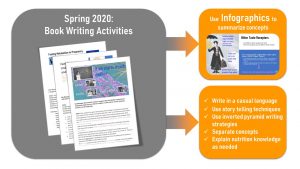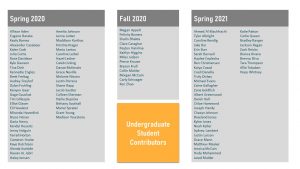Nutrition Through the Life Cycle: An OER Created in Collaboration With Undergraduate Students
If I had written this OER all by myself it would have looked very differently. Instead the OER ended up having a very unique format and the driving force behind this format are my students. Over the course of four semesters my undergraduate students and I went on a journey asking ourselves:
What would a textbook for a Nutrition Through the Life Cycle undergraduate course need to look like that is not a chore to read and supports conceptual learning?
Fall 2019: Deciding on Content
The course came to me in the usual way. A faculty colleague retired. When I looked at the course and the existing textbooks it became quickly clear that this course was still taught the way I took it ages ago. The way we see nutrition has changed a lot since then.
At the beginning of the 21th century a WHO report suggested that chronic diseases that were once see as a problem of lifestyle during the middle years of life need to be seen in a life cycle approach. Factors accumulating during growth and development have long-reaching effects on metabolism and physiological functioning and add risks to the development of chronic diseases. These early risks accumulate, but can be modified later in life. The more risk factors accumulate the higher the risk for an early onset of chronic diseases. Chronic diseases shorten life and lower quality of life.
Therefore I decided to adopt the critical period model for this course. The course starts out explaining the development of chronic diseases and then follows the critical periods through the lifecycle observing how factors can contribute or modulate the risk for chronic diseases.

Spring 2020: Undergraduate Students Write Their Own Textbook

Spring 2020 was the first semester I offered the course. I supplied the students with my PowerPoint slides and asked them to take good notes. Some students used the notes section under the slides, while others used tablets or paper copies to pencil their notes into the slides. At the end of each module I set up Google Docs for each chapter and the students pooled their notes writing their own textbook to study from while I made sure their content was factually correct.
During the book writing experience a first conceptual idea for the textbook began to form. The students stated that the PowerPoint slides with more detailed content were aiding their learning and over the course of the semester the infographics summarizing concepts developed.
The students also stated that the chapters needed to be written in a casual tone telling the story of the concept instead of listing and describing facts. Prior nutrition knowledge needed to understand a new concept should be reviewed as needed, terms defined. Lastly concepts should be clearly identifiable.
Fall 2020: The OER Takes Form
For fall semester I received a grant that allowed me to hire two undergraduate student workers. The two student workers combined the sections written by the undergraduate students of the spring and fall 2020 courses into a first draft of the Pressbook OER. They also completed additional research, developed additional content interesting to undergraduate students and edited infographics.
Students in the fall course kept giving ample amounts of oral feedback. Infographics, clearly identifiable concepts, and casual writing were at the top of their wish list. In addition students suggested that the written text should be concise so that chapters could be read before a class in 30 minutes.
Spring 2021: The OER is Live
During the spring semester I started deploying surveys in the course. The feedback was extremely positive and exam grades testing conceptual learning very good.
- 78 % of the students in the spring 2021 course used the OER on a regular basis.
- 84 % felt that the OER contributed to better understanding of the course content.
- Students appreciated that they can use the OER in various ways.
“I really like the OER. I would like it if we had one for each class.“
“I use the OER to lock in my knowledge and by adding extra knowledge I didn’t know previously to complement existing baseline knowledge. Finding a topic and then reading more in depth to get more detail is very beneficial for the quizzes and exams.”
“I really like the infographics. They helped compact a concept into one area where I could easily go to. It simplified the concept and helped me understand the overall process.”
Since spring 2021 OER editing is taking place and content is expanding. I big thank you to Dr. Eric Buhs for writing The Social Influences of Peers and Parents on Body Image and Eating Behaviors chapter, and to Dr. Heather Rasmussen and Dr. Sunil Sukumaran for supplying me with narrative reviews and editing chapters.
Here is everybody who made this OER possible. I couldn’t have done it with out them:
The students involved in the project were:



Feedback/Errata
14 Responses to Nutrition Through the Life Cycle: An OER Created in Collaboration With Undergraduate Students